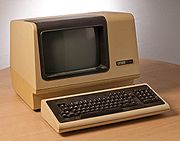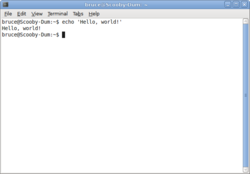
Headless system
Encyclopedia
A headless system is a computer system or device that has been configured to operate without a monitor (the missing "head"), keyboard and mouse. A headless system is typically controlled via a network connection, although some headless system devices require a connection to be made via RS232 for administration of the device.
BIOS
versions will wait indefinitely for a user to press a key before proceeding if some basic devices are not installed or connected, effectively halting an unattended system. These can include:
On more modern systems, the BIOS factory setting will typically be configured to behave this way as well, but this setting can be changed via a BIOS setup facility to proceed without user intervention.
Even in cases where a system has been set up to be managed remotely, a local keyboard and video card may still be needed from time to time, for example to diagnose boot problems that occur before a remote access application is initialized.
offers a solution called Integrated Lights-Out
(ILO) that provides this functionality. Remote access to the system is gained using a secure web connection to an IP address assigned to the ILO adapter, and allows for monitoring of the system during start-up before the operating system is loaded.
Another hardware solution is to utilize a KVM-over-IP
switch. Such a switch is a traditional Keyboard-Video-Mouse sharing device with the added ability to provide remote control sessions over IP. Connection to the KVM device is gained using a web browser, which allows for remote monitoring of the connected system console port.

 In the past systems were typically administered through a text-based interface such as a command line in Unix. These interfaces were often called 'virtual terminals' or 'terminal emulators', as they attempted to simulate the behavior of "real" interface terminals like the Digital Equipment Corporation
In the past systems were typically administered through a text-based interface such as a command line in Unix. These interfaces were often called 'virtual terminals' or 'terminal emulators', as they attempted to simulate the behavior of "real" interface terminals like the Digital Equipment Corporation
's VT100
.
Later on, systems such as X Window System
and VNC combined with virtual display drivers allow remote connections to headless machines through ordinary Graphical user interface
s, often runnning over network protocols like the internet's TCP/IP.
PC BIOS limitations related to headless operation
During bootup, some (especially older) PCPersonal computer
A personal computer is any general-purpose computer whose size, capabilities, and original sales price make it useful for individuals, and which is intended to be operated directly by an end-user with no intervening computer operator...
BIOS
BIOS
In IBM PC compatible computers, the basic input/output system , also known as the System BIOS or ROM BIOS , is a de facto standard defining a firmware interface....
versions will wait indefinitely for a user to press a key before proceeding if some basic devices are not installed or connected, effectively halting an unattended system. These can include:
- a video cardVideo cardA video card, Graphics Card, or Graphics adapter is an expansion card which generates output images to a display. Most video cards offer various functions such as accelerated rendering of 3D scenes and 2D graphics, MPEG-2/MPEG-4 decoding, TV output, or the ability to connect multiple monitors...
; - a keyboardKeyboard (computing)In computing, a keyboard is a typewriter-style keyboard, which uses an arrangement of buttons or keys, to act as mechanical levers or electronic switches...
.
On more modern systems, the BIOS factory setting will typically be configured to behave this way as well, but this setting can be changed via a BIOS setup facility to proceed without user intervention.
Even in cases where a system has been set up to be managed remotely, a local keyboard and video card may still be needed from time to time, for example to diagnose boot problems that occur before a remote access application is initialized.
Hardware remote control
Some servers provide for remote control via an internal network card and hardware that mirrors the console screen. For example, HPHewlett-Packard
Hewlett-Packard Company or HP is an American multinational information technology corporation headquartered in Palo Alto, California, USA that provides products, technologies, softwares, solutions and services to consumers, small- and medium-sized businesses and large enterprises, including...
offers a solution called Integrated Lights-Out
Integrated Lights-Out
Integrated Lights-Out, or iLO, is an embedded server management technology exclusive to Hewlett-Packard but similar in functionality to the Lights out management technology of other vendors....
(ILO) that provides this functionality. Remote access to the system is gained using a secure web connection to an IP address assigned to the ILO adapter, and allows for monitoring of the system during start-up before the operating system is loaded.
Another hardware solution is to utilize a KVM-over-IP
KVM switch
A KVM switch is a hardware device that allows a user to control multiple computers from a single keyboard, video monitor and mouse. Although multiple computers are connected to the KVM, typically a smaller number of computers can be controlled at any given time...
switch. Such a switch is a traditional Keyboard-Video-Mouse sharing device with the added ability to provide remote control sessions over IP. Connection to the KVM device is gained using a web browser, which allows for remote monitoring of the connected system console port.
Software remote control


Digital Equipment Corporation
Digital Equipment Corporation was a major American company in the computer industry and a leading vendor of computer systems, software and peripherals from the 1960s to the 1990s...
's VT100
VT100
The VT100 is a video terminal that was made by Digital Equipment Corporation . Its detailed attributes became the de facto standard for terminal emulators.-History:...
.
Later on, systems such as X Window System
X Window System
The X window system is a computer software system and network protocol that provides a basis for graphical user interfaces and rich input device capability for networked computers...
and VNC combined with virtual display drivers allow remote connections to headless machines through ordinary Graphical user interface
Graphical user interface
In computing, a graphical user interface is a type of user interface that allows users to interact with electronic devices with images rather than text commands. GUIs can be used in computers, hand-held devices such as MP3 players, portable media players or gaming devices, household appliances and...
s, often runnning over network protocols like the internet's TCP/IP.

